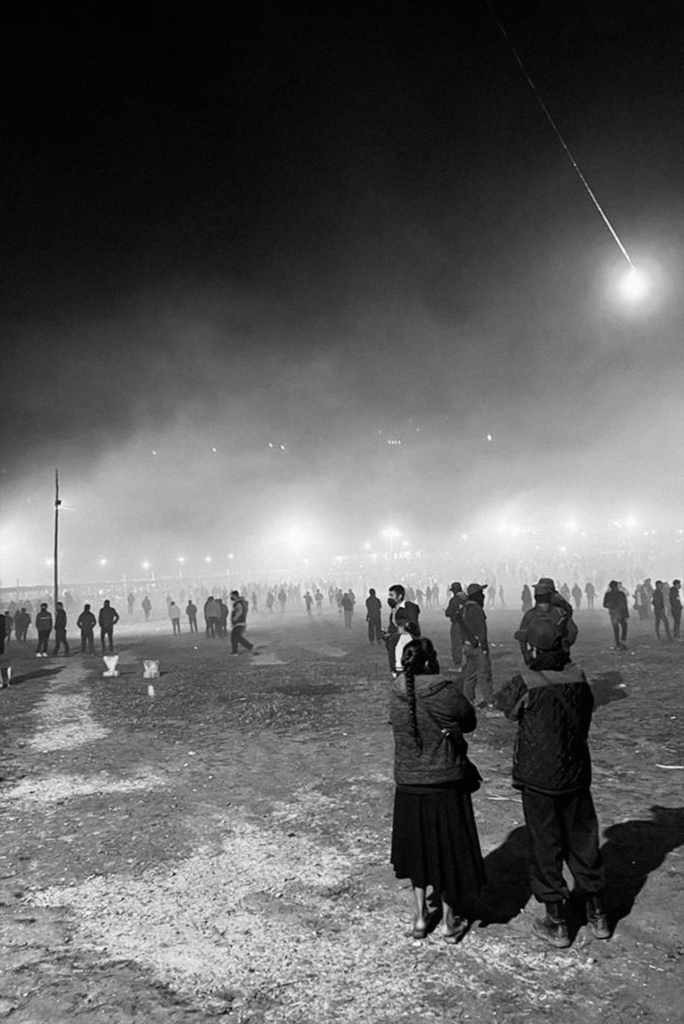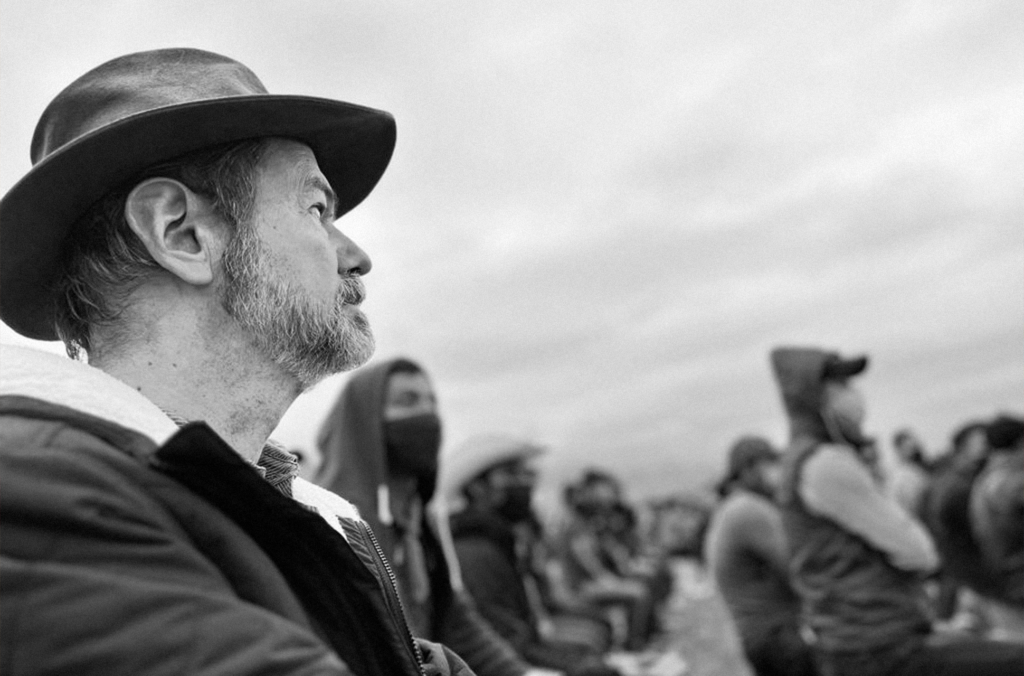
Eccentric Normality
After renewing communication with an effective theater of gestures, a river of stories, proclamations and aphorisms, and adventures as special as sending seven Zapatistas to Europe on a sailboat, the EZLN has moved on to another variant of the speech: hermeticism. This is not a concealment; its symbolic tapestry is decipherable, but requires new keys to be understood.
In the mid-nineties, the region was visited by Oliver Stone, José Saramago, John Berger, Danielle Mitterrand, Manuel Vázquez Montalbán, among many others, and Subcomandante Marcos gave interviews to the mainstream international media. Today, for unfathomable reasons, the EZLN repudiates publicity.
In 2014, Marcos disappeared as a political figure and became Galeano, in homage to a Zapatista teacher murdered that year. For some, in this way he squandered media capital accumulated over two decades. However, it also demonstrated that the cause did not depend on a charismatic leader. When he became Galeano, Marcos stopped being the spokesperson for the EZLN and lost prominence. He reappeared as Marcos in 2023, but with the rank of captain, which perhaps alludes to defensive tasks. Interestingly, many of the people who criticized him for promoting idolatry now long for his iconic presence.
Few leaders take the step back that Marcos took. The gesture confirmed that Zapatismo does not seek to occupy spaces of power, not even within its own ranks. “For us, nothing” or “Help us to disappear, to not be possible” are some of his most repeated slogans. However, Marcos’s removal from cameras and microphones, commendable for ethical reasons, weakened Zapatista communication. Added to this is a media policy that makes press conferences and interviews difficult. In 2021, 150 Zapatistas arrived in Europe as part of an “air battalion” to establish links with groups that defend the territory and biodiversity. They did not act in secret, but they did not seek to make their task visible either. I spoke about this with Andrea Cegna, an Italian journalist who participates in a pro-Zapatista association in Brescia and writes for Il Manifesto and Il Fatto Quotidiano. “I don’t quite understand the new relationship with the media,” he commented in Dolores Hidalgo: “Subcommander Moi gave a press conference in Vienna, but then he couldn’t talk to them, and I’m not referring to his attitude towards the dominant media, who may be suspicious, but before the independents, who have supported them. We want to spread his ideas, but we can’t always.” The withdrawal of information remains an enigma. Did the jugglers voluntarily tie their hands? Is their silence the echo chamber of what they have already said? Are they waiting for another moment to recover their eloquence?
On December 30th, the press was forbidden from entering the Caracol. That day he was dedicated to presenting plays. Is there another movement that dedicates itself with such passion to dramatic art? There was no obvious reason to keep the journalists away, and that contributed to the perplexity. Were we facing a strange variant of proselytism, which encourages desire with prohibition? Do the new lines of command distrust the openness with which they acted in the past? Questions and more questions. Experts in communication, the Zapatistas now privilege confusion, an alternative form of communication.
Several speakers were expected, including Marcos or one of the many women who accompanied Marichuy Patricio’s campaign in 2017 and 2018. However, only Moisés appeared on the platform, with the commanders sitting behind him. He did not evoke the years of struggle in festive or epic terms nor did he make announcements about the future of the movement. For twenty minutes he spoke in Tzeltal, improvising passages that he then reproduced in Spanish. He referred to Zapatismo’s vocation for peace, but also to its willingness to defend itself, and remembered the absent people who had made this act possible and were remembered with empty chairs: from the searchers who wish to know the fate of their children to the fallen in the struggle, passing through the ancestors who demand justice from beyond. His words were as clear as they were predictable. What we heard was normal, but the Zapatistas rarely are. I thought of the novel by Erich Maria Remarque whose title, with deliberate ambivalence, described the situation: All Quiet on the Western Front. The biggest surprise came from the lack of news. The Zapatistas delivered an envelope marked urgent, but the letter had to be placed inside by the recipients.
None of this diminished the enthusiasm of the attendees, which at that point was already feeding on itself.

Juan Villoro, Chiapas. Photo by Sofía Grivas.
Ways of Understanding
Thanks to Zapatismo, for thirty years we have come into contact with other ways of evaluating the representation of events. Iván Prado, axis of the group Payasos en Rebeldía, told me about the strangeness that he felt in his first contacts with the Caracoles audience: people were not laughing. He thought they didn’t like the show, but at the end of the performance they explained the cause of the silence: “If we laugh, we stop understanding.” The drama of comedy is that, by connecting with the audience, it causes laughter that prevents them from continuing the piece; what is gained in empathy is lost in meaning. A year later, Iván returned to Chiapas. Those who heard him in silence punctually recited his words.
Jordi Savall, viola da gamba virtuoso, comments that the greatest praise he has received for a concert occurred in Chiapas. An indigenous person told him: “When I hear it, I feel like I love my son more.” This transfer of emotion—for this feeling that—encrypts the essence of art.
Another peculiar experience occurred during the film festival held at Caracol de Oventik in 2018. It was there where the film Roma had its premiere in Mexico. At the birth scene, numerous Zapatistas put their hands under their balaclavas to wipe away their tears. Despite this evidence of empathy, the Europeans watching the performance felt that something was missing; accustomed to film-debate sessions, they wanted to hear the communities’ opinions. It is common to think that each viewer relates individually to what he sees, but the Zapatistas have other conventions. When they were asked about the movies, they said, “We have to get together to find out what we think.” A Frenchman who works for the Biarritz Festival told me that this seemed like an act of censorship: the public should give their opinion freely. But the cause of that reaction was different. In most indigenous communities, meaning is forged collectively. Only when discussing in a group do ideas become clearer; what one thinks is irrelevant to what is commonly thought. Basically, the practice is not too far from something that also happens in cities. When a movie is worth it, it continues to be discussed at the dinner afterward. For this reason, the Argentine director and playwright Mauricio Kartun points out that every successful work “flies over the Milanese.” Gathered around food, we talk, not so much to impose individual opinions, but to understand what we think. This exercise lacks cultural prestige, but is usually more instructive than that of specialized criticism.
The meeting in Dolores Hidalgo faced the challenge of understanding. What messages were unraveled by the public who drank punch and walked along the grassy esplanade, avoiding the children who ran everywhere? There were campesinos who spoke forty native languages, retirees from Latin American guerrillas, expeditionaries of otherness, graduates of disappeared political parties, Europeans in search of a geography without maps, Christians outside the ecclesiastical hierarchy, romantics generously dedicated to the task, many sometimes sacrificial, to improve the world. The only incontrovertible thing was the safety and excitement of the children.
The journalist and filmmaker Diego Enrique Osorno traveled to Dolores Hidalgo to present La Montaña, a documentary about the nautical journey of the Zapatistas. With a gaze trained to register the dialogue between reality and its witnesses, he told me something that I had not noticed: during the day, Moisés remained on the main stage, a small wooden pavilion with no decoration other than the photos of the Zapatista dead. From there he saw all the plays. A suggestive feature of his speech was the importance he attached to the way in which young people represent reality. He praised the meaning of theater, but asked to bring that message to the world of facts. And he added something that did not seem intended for the communities, but for visitors: “You have to organize.” For thirty years, devotees of the cause have gone to Chiapas in search of new light. The pending challenge is to be a Zapatista outside of Zapatista territory.
Those of us who came from afar had received an injection of adrenaline. To that extent, the experience was fully justified. The question was what to do next, how to ensure that the experience did not slip away, how to continue it in very different conditions and scenarios. Beyond the next Zapatista call, could we organize on our own?
Some already achieve it. A Greek group arrived with the calendar that they sell every year in support of the EZLN. The texts recover testimonies from oral narrators—a new version of the rhapsodes—to accompany the counting of the days. The fundraising they achieve for the benefit of communities is impressive, but the most significant thing is that they remember that measuring time is a political fact
The Future Starts on Monday
Since the early hours of January 1st, 1994, the Zapatistas have seen six presidents of the Republic come and go. Their struggle endures among the evanescent partisan struggles. “We are going slowly because the road is long,” they say to indicate that their temporality is calculated differently.
After thirty years of sunrises we met in a region governed by cosmic cycles since Mayan antiquity. The orderly transits of the sun supported the cause: the future properly began on Monday.
The sober speech of Sub-commander Moisés was received with applause that was immediately replaced by an explosion. The air was filled with rockets and fireworks that cannot be missing at any Mexican party.
I met with Andrés in the center of the field. Thirty years ago, he heard another type of detonations and since then he contracted the Zapatista “dignified rage.” Now gunpowder was the ammunition of the celebration. Those from far and near, gathered for an unrepeatable date, prepared to dance until the sun regained its dominions.
Little by little, the smoke cleared and we could see the full moon. People don’t always do their job, but the astral choreography was perfect. Full moon Sunday. Everything was in balance, but something could change in the heights. A cloud covered the moon, reminding us that that night everything was as fragile and resistant as dreams.
JUAN VILLORO. As a journalist he has obtained the Manuel Vázquez Montalbán, Catalunya and Diario Madrid awards, among others. He has been a professor at the Ibero-American Journalism Foundation created by Gabriel García Márquez. His chronicles have been collected in books such as Horizontal Vertigo. A City Called Mexico, The Tribe’s Eleven, and Accidental Safari. He has addressed Zapatista issues since 1994, with his coverage of the “Aguascalientes Convention.” In 2022, he received the Gabo Foundation Award in Colombia for his journalistic career.
Original article by Juan Villoro at https://gatopardo.com/reportajes/ezln-un-amanecer-de-treinta-anos.
Translated by Schools for Chiapas.
